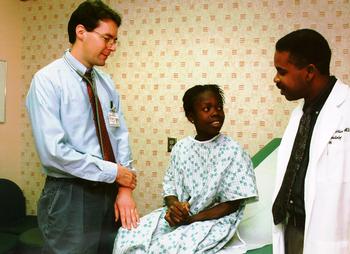New device bypasses need for some open heart surgeries

Dr. Thomas Doyle (left), with 16-year-old patient Marie Mirvil, of Haiti, and Dr. Casnel Fleurelas. Photo by Donna Jones Bailey.
The marriage of military research and medicine has resulted in a new device to correct a common congenital heart defect without the need for open heart surgery.
Pediatric cardiologists at Vanderbilt Children's Hospital will soon begin testing the new device in children who were born with an atrial septal defect (ASD), a hole in the upper chamber of the hearts.
"Until recently, ASD has required open heart surgery to correct, which means putting the child on heart-lung bypass, a hospital stay of several days and a scar across the chest," said Dr. Thomas P. Doyle, assistant professor of Pediatrics.
"For several years, researchers have been trying to design devices that could be inserted through a vein and positioned in the heart to block this opening. A number of variations and generations of devices are now in clinical trials. I believe the device we'll be testing is the best of all the devices currently available and will probably revolutionize the way we close an ASD."
The new device is made of a metal called nitinol, which is a nickel titanium combination developed in a U.S. Navy laboratory.
"The advantage of this metal is that once it's made into a certain form, you can bend it, then let it go and it retains its original shape," Doyle said. "This would enable the device to become a long, thin structure that will fit inside a small catheter. Then we'll be able to thread it through a vein in the leg and up to the heart, where we can put it back into its original shape and position it across the hole."
The device's shape ‹ a narrow tube in the center with wider ends for support ‹ also allows for its small size. Its shape gives it a "self-centering" capability to make sure that the entire hole is covered, Doyle said. Some other devices must be larger on each side to provide a margin of error in case the device is not positioned at the exact center of the hole, he said.
"In the cath lab, we'll measure the size of the patient's ASD and pick the occluder of the corresponding size," he said. "Like a patient takes a certain shoe size, he or she will take a certain size of this occluder."
ASDs are one of the most common congenital heart defects, accounting for about 7 percent of heart defects that can be present at birth. The defect allows extra blood volume into the right side of the heart, which taxes the heart and can reduce exercise tolerance and stamina, Doyle said.
"In a small percentage of people, that extra blood volume can lead to irreversible damage of the lungs," he said. "An ASD also creates a communication between the two sides of the heart that can allow the passage of a blood clot, which can then go to the brain or heart and cause a stroke or heart attack."
When an ASD is diagnosed, the lesion is typically recommended to be closed, usually at about 2 to 4 years of age, he said.
VUMC will be one of up to 20 centers across the country comparing the new occluder with surgery in a Phase 2 trial approved by the Food and Drug Administration.
"We will be comparing the device with surgery in terms of outcome ‹ how well we are able to close the defect as well as morbidity, mortality and financial costs," Doyle said.
"The potential benefit of this device is that we could put it in through someone's leg and essentially four hours later, the patient could be walking around and be ready to go home the next day. The patient wouldn't have to go into an intensive care unit, wouldn't need a lengthy hospital stay and there would be essentially no scar.
"So far, in the early trials and in its early use in Europe, the results in humans have been very exciting," Doyle said.













